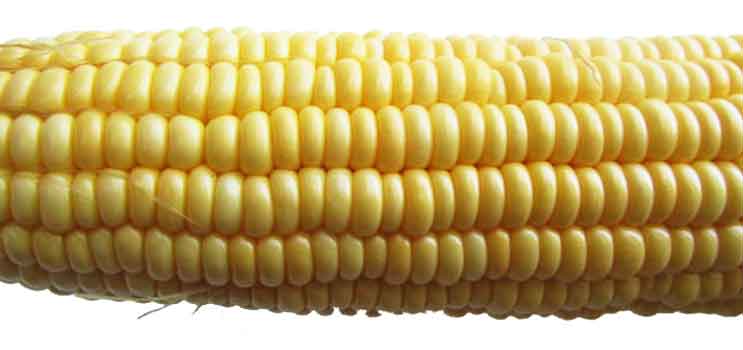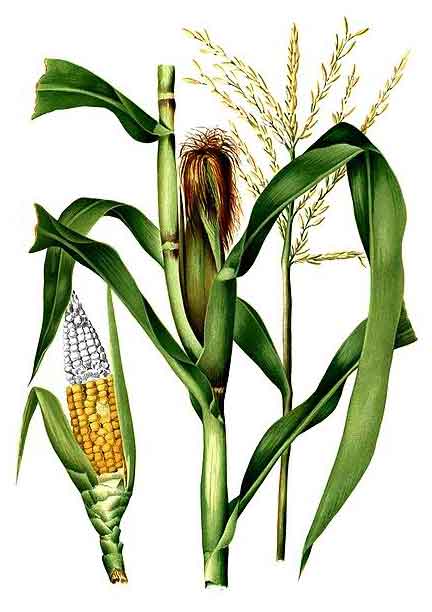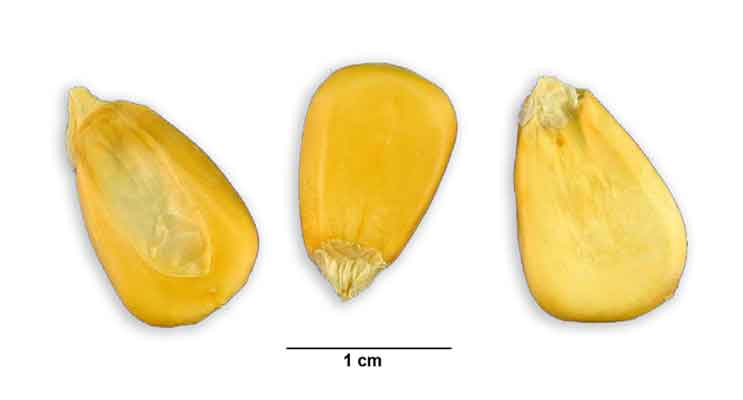|
Botany
Mais is a very coarse, erect, tall grass, 1.5 to 2 meters high. Stem is solid, with a soft and spongy center. Leaves are numerous and close together,
30 to 100 centimeters long and 2 to 10 centimeters wide, linear lanceolate. Male inflorescence is erect and terminal; the female inflorescence on the axils of the leaves, cylindric and large. The individual
fruit (grain) is is roundish or reniform, compressed, smooth, shining, yellow, white, reddish or even purplish-black.
Distribution
- Extensively cultivated in most parts of the
Philippines. In some islands and provinces, it is a staple article of food.
- Native of America.
- Extensively grown in the tropics and temperate regions of the world.

Constituents
- Analysis showed percentage of carbohydrate is high, with a good content of protein and fat, with a higher percentage of protein and fat than any other cereal.
- Corn lacks gluten.
-
Constituents: Flavonoids, chlorogenic acid, saponins, volatile alkaloid,
allantoin, tannins, resin.
- Corn silk yields maizeric acid, 2%; fixed oil; resin; sugar; mucilage
and salts.
- Nutrient analysis per 100 g
of edible portion: (Proximates) water 76.05 g, energy 86 kcal and 360 kJ, protein 3.27 g, total lipid (fat) 1.35 g, ash 0.62 g, carbohydrate by difference 18.70 g, total dietary fiber 2.0 g, total sugars 6.26 g, sucrose 0.89 g, glucose (dextrose) 3.43 g, fructose 1.94 g, starch 5.70 g; (Minerals) calcium 2 mg, iron 0.52 mg, magnesium 37 mg, phosphorus 89 mg, potassium 270 mg, sodium 15 mg, zinc 0.46, copper 0.054, manganese 0.163 mg, selenium 0.6 µg; (Vitamins) ascorbic acid 6.8 mg, thiamin 0.155 mg, riboflavin 0.055 mg, niacin 1.770 mg, pantothenic acid 0.717 mg, vitamin B6 0.093 mg, total folate 42 µg, total choline 23.0 mg, beta carotene 47 µg, alpha carotene 16 µg, cryptoxanthin beta 115 µg, vitamin A IU 187 µg, lutein + zeaxanthin 644 µg. (17)
- Study of hair extracts yielded flavonoids, saponin, tannins, phlobatannins, phenols, alkaloids, and cardiac glycosides in both AE and ME. Terpenoid compounds were found only in the ME. Total phenolic content in the aqueous extract was significantly higher (42.71 ± 0.87 µg/g of tannic equivalent (TAE) compared to the methanolic extract (40.38 ± 1.10 µg/g of TAE). (19)
Properties
- Considered anodyne, antilithic, antiseptic, cholagogue, demulcent, diuretic, hypoglycemic, hypotensive, lithotriptic, tonic, vasodilator.
- Studies suggest
hypoglycemic, antioxidant, antimicrobial, anticataract, nephroprotective, antinociceptive, anti-inflammatory, antiplasmodial, aphrodisiac, antidepressant properties.
Parts used
Hairs and cobs.
 Uses Uses
Edibility / Nutritional
• Edible parts: Pollen, seed (raw or cooked), stem.
• Good source of carbohydrates,
B vitamins (riboflavin and thiamine), vitamin A and C, potassium and
zinc; rich in protein.
• Corn syrup is used in the manufacture of jams, jellies and
other sweets.
• Corn syrup is often used in combination with cane sugar and maple syrup.
• Corn starch is well known for its many uses.
• Edible oil is obtained from the seed, used for salads or cooking.
• Roasted seed use as a coffee substitute.
Folkloric
• Diuretic: Take decoction of hairs or cobs as tea.
• Decoction of pith of cob as tea is used for stomach complaints.
• Decoction of roots, leaves, and corn silk used for dysuria, bladder
complaints, and bed-wetting.
• The water in which unhusked corn is boiled is a pleasant tasting remedy
for urinary tract infection. The corn silk decoction is also thought
to be diuretic.
• Good emollient poultice used for ulcers, rheumatic pains and swellings.
• Decoction of parched corn (burned or roasted) taken as tea for nausea
and vomiting.
• Infusion of parched corn allays the nausea and vomiting of many diseases.
• Kidney stones: Infusion of corn hair in hot water, 3x daily.
• Poultice of corn silk for wounds and sores.
• In Europe, corn silk (stigma) used for genitourinary diseases. Also used for similar purposes in French Guinea, India, Spain and Greece.
• In China, corn silk is used for fluid
retention and jaundice.
• In Nigeria, root decoction used for treatment of malaria. (22)
Others
• The embryo is rich in oil and used widely for cooking, manufacture
of soaps.
• Sticky gum containing dextrin used for sealing envelops and gummed labels.
• Corn syrup is used in the manufacture of jams, jellies and
other sweets.
• Corn starch is well known for its many uses.
• Glue made from the start in the seed.
• Used for making alcohol.
• Cobs used to supply potash and by distillation can yield acetic acid and acetone. By controlled fermentation, may also yielded nitro-cellulose lacquers.
• Starch used in cosmetics.
• Stem fiber used in making paper.
• Corn spathe used for making straw hats and baskets.
Preparation
• Corn silk
infusion, fresh or dried: cystitis, 1 cup 3x daily.
• As tincture: 3 cc (50 drops) 3x daily for cystitis.
 Studies Studies
• Diuretic / Histopathological
Studies: Three
indigenous medicinal plants were studied: C citratus, R sativus, and
Zea mays. No morphometrical or histological changes were noted in the
liver and kidney of rats. Study concludes that the common use of these
indigenous diuretic plants is safe.
• Diuretic / anti-lithiasis effect: The influence of Zea mays on urinary risk factors for kidney stones
in rats: The study suggests the possible antilithiatic effect
of ZM infusion is probably through some diuretic activity. (4)
• No Diuretic Effect: In a study of four traditional Vietnamese herbal remedies (Z mays, I cylindrica, Plantago major, O stamineus) claiming to increase diuresis, no diuretic effect was seen in a placebo-controlled double-blind crossover model.
• Suppression of Progression of Diabetic Glomerular Sclerosis: Study evaluated the effect of Z. mays on streptozotocin induced diabetic nephropathy in rats. Results indicate the WE of ZM
suppressed the progression of diabetic glomerular sclerosis in ST-induced
diabetic rat. (5)
• Anti-Tumor Necrosis Factor: Interfering with leukocyte adhesion is important in the treatment of bacterial sepsis and inflammatory diseases. Study of the crude methanolic extract of Zea mays exhibited significant TNF antagonistic activity and concludes that corn silk has potential for TNF- and LPS-mediated leukocyte adhesion and trafficking. (6)
• Renal Effects: In water-loaded conscious rats (2.5 cc/100 body wt), corn silk aqueous extract was found to be diuretic at 500 mg KBW and kaliuretic at 300 and 500 mg KBW. At 5.0 cc/100 g BW, CSAE is kaliuretic at 500 mg KBW but glomerular filtration and filter load decreased without affecting proximal tubular function, sodium or uric acid excretion. (8)
• Antibacterial Activity: Zea mays alcoholic extract showed activity against Klebsiella pneumonia, E coli, Salmonella paratyphi A, Salmonella typhi and B. subtilis.
• Dissecting Tocopherols Content: Study identified QTLs (quantitative trait loci) with major effects in the natural variation of tocopherols in maize grain. Study provides a guideline for breeders to improve traits that can minimize the risk of malnutrition, especially in developing countries. (12)
• Mays Hair Extracts / Phytochemicals and Phenolic Content: Study screening mays hair extracts for bioactive compounds yielded saponins, flavonoids, tannins, phlobatannins, phenols, alkaloids, and cardiac glycosides in both aqueous and methanolic extracts. Findings suggest potential applications as therapeutic and antioxidative agents in pharmaceuticals, food, and other related industries. (13)
• Nutritional Evaluation of Baby Corn: Study showed baby corn is a good source of various nutrients like protein, carbohydrates, crude and dietary fibers, and is a par or even superior in nutritional qualities to many other commonly used vegetables. (14)
• Anti-Inflammatory / Husks: Study evaluated the anti-inflammatory effect of Z. mays husk extract on NO production and release of soluble intercellular adhesion molecule and eotaxin-1. Results showed the anti-inflammatory effect via down-regulation of expression of iNOS gene which was mediated by inhibition of NF-kB and AP-1 signaling. (16)
• Antimicrobial / Flavonoid Glycosides / Corn Silk: Corn silk refers to stigmas of female flowers of Zea mays. Study evaluated different solvent extracts and flavonoids of corn silk for antimicrobial activities against twelve pathogenic bacteria and yeast C. albicans. Extracts and flavonoids showed antimicrobial activity with significantly (p<0.05) higher sensitivity against a number of bacterial than gentamycin. (18)
• Anticataract / Suppression of Aldose Reductase: Study evaluated the anticataract effect of Zea mays (purple waxy corn) in experimental diabetic cataract. Results showed both medium and high doses of extract decreased lens opacity together with decreased MDA level. Mechanism may be through decreased oxidative stress and suppression of aldose reductase, the rate limiting enzyme in the polyol pathway. (20)
• Analgesic / Anti-Inflammatory / Husk: Study evaluated the analgesic (hot plate and formalin induced paw licking models) and anti-inflammatory effects (carrageenan and cotton pellet models) of aqueous extract of Z. mays husk in male wistar rats. Results suggest analgesic and anti-inflammatory activity which may be due to tannins and polyphenolic constituents. (21)
• Antiplasmodial / Cytotoxicity /
Roots: Study evaluated a root extract of Zea mays for antimalarial activity against Plasmodium berghei in rodent malaria models. Results suggest the root extract may possess antimalarial activity against both chloroquine-sensitive and resistant malaria. (22)
• Antioxidant / Phenolic Profile / Corn Silk: Study evaluated phenolic acid, flavonoid and mineral matter profiles of corn silks. Corn silks at silking stage are more suitable as natural source of phenolic compounds than silks at R4 dough stage. The most abundant phenolic compounds were hydroxy- cinnamic acid ester and luteolin derivative i.e. 3-O-caffeoylquinic acid and maysin, respectively. (23)
• Antinociceptive / Anti-Inflammatory / Roots: Study evaluated the anti-inflammatory and analgesic activities of Z. mays ethanol root extract in mice using various experimental models i.e. acetic acid and thermal-induced pains and carrageenan, egg albumin and xylene-induced edema. Results showed significant (p<0.05-0.001) dose-dependent reduction of inflammation and pains induced by different phlogistic agents used. Effects were comparable to standard drug, acetyl salicylic acid. (24)
• Antidepressant /
Husk: Study evaluated a husk extract for antidepressant activity in mice using open field, force swimming and tail suspension tests. Results showed significant antidepressant activity attributed to phenolic contents. (25)
• Aphrodisiac: Study evaluated aqueous crude extract of purple corn for aphrodisiac properties in a male rat model. Results showed aphrodisiac effects as evidenced by significant increase in arousal, increase in number of discharges of ejaculatory motor patterns and total number of genital motor patterns. (26)
• Hypoglycemic / Corn Silk: Study evaluated the hypoglycemic effect of methanolic extract of corn silk in streptozotocin induced diabetic rats. Results showed significant hypoglycemic effect in both type I and type II models. The hypoglycemic mechanism in type-I may be due to regeneration of beta-cells as evidenced by increase of insulin production. (27)
• Cardiotoxicity
Study / Acute Toxicity Study / Corn Silk: Study evaluated corn silk extract for safety using histopathological parameters and ECG in rats using graded doses (200, 400, and 800 mgkg) of extract for seven days. Acute toxicity study showed the aqueous extract of corn silk to be safe for medicinal use as evidenced by the absence of lethality at 3200 mg/kg dose. ECG study showed significant electro-cardiographic changes which were corroborated by histological examination of the heart. The histological changes were similar to arrhythmogenic right ventricular dysplasia/cardiomyopathy. Study suggest that despite its safety profile, caution is advised when using corn silk in patients with compromised heart health conditions. (28)
• Nephroprotective / Antioxidative / Husk: Study evaluated the antioxidative stress and renoprotective activities of husk extract and fractions using oxidative stress markers, kidney functions and renal histopathlogy. Results showed antioxidative and nephroprotective potentials which may be due to antioxidant activities of phytochemical constituents. (29)
Availability
Commercial cultivation.
Corn silk, tea extracts in the cybermarkets.
|



![]()

